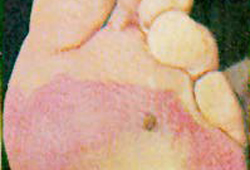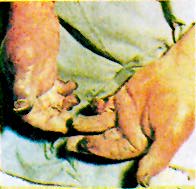History and exam
Key diagnostic factors
common
presence of risk factors
Key risk factors include cold exposure, previous frostbite, and vascular insufficiency.
cold or numbness of affected extremity
The most common early symptoms of the affected extremity.
pain during rewarming
76% of patients report extreme pain during rewarming phase.[1]
purplish skin discoloration
Many patients have purplish discoloration that resembles cyanosis or early ecchymosis.
white or yellowish, waxy skin discolouration
A white or yellowish waxy discolouration in the area of injury is seen with first-degree injury. [Figure caption and citation for the preceding image starts]: Grade II frostbite injury of the footLloyd EL, BMJ 1994; 309:531-534 [Citation ends].
superficial skin vesiculation
The classic sign of a second-degree injury, with clear or milky fluid in blisters, surrounded by erythema and oedema.
deep purple blisters
Indicates third- or fourth-degree injury.
The purple colour is caused by blood-containing fluid in the blister, indicating injury into the reticular dermis and beyond the dermal vascular plexus.[Figure caption and citation for the preceding image starts]: Grade IV frostbite injury inappropriately thawed using boiling waterLloyd EL, BMJ 1994; 309:531-534 [Citation ends].
uncommon
tissue necrosis and mummification (dry gangrene)
This occurs at a later stage (10 to 14 days) and indicates fourth-degree injury.
Affected tissue appears black and necrotic.
Mummified tissue appears black and shrivelled due to extreme dehydration. [Figure caption and citation for the preceding image starts]: Grade IV frostbite injury inappropriately thawed using boiling waterLloyd EL, BMJ 1994; 309:531-534 [Citation ends].
Other diagnostic factors
common
erythema
Usually occurs in the presence of other skin changes.
More commonly associated with chilblains if other skin changes are absent.
uncommon
joint dislocation
Associated with weight-bearing on frostbitten feet or concurrent trauma.
fractures
Associated with weight-bearing on frostbitten feet or concurrent trauma.
Risk factors
strong
cold exposure
previous frostbite
Injured tissue has prolonged reduction in tolerance to cold. It is therefore thought to be more susceptible to injury if cold exposure is repeated.[1]
weak
hypoxia
Reduces reasoning powers and leads to a tendency towards laziness, carelessness, indecision, and lack of normal insight and judgement.[1]
alcohol
tobacco
Reduces normal peripheral circulation, increasing susceptibility to injury.[1]
dehydration
Decreases tissue perfusion.
extremity trauma
Alters normal physiology and normal tissue perfusion.
constrictive clothing or equipment
Interferes with distal tissue perfusion.
Use of this content is subject to our disclaimer